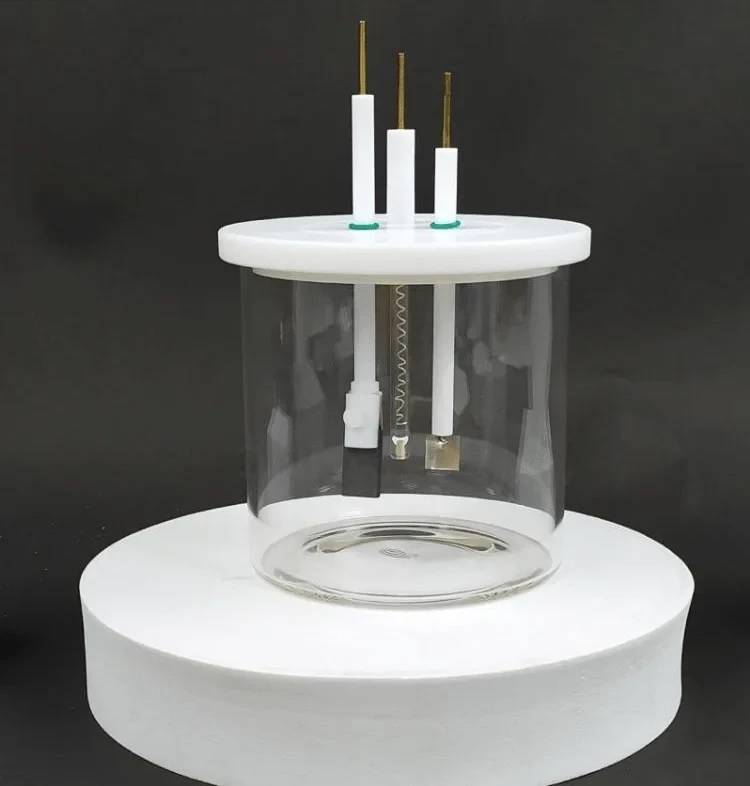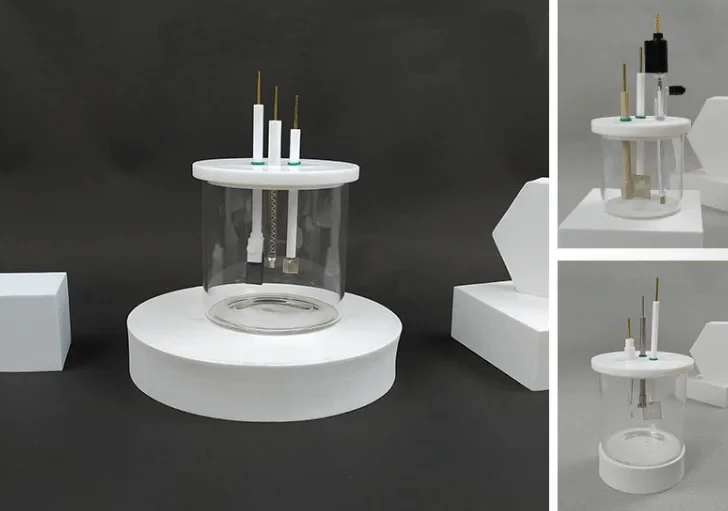
Electrochemical Consumables
Glassy Carbon Sheet RVC for Electrochemical Experiments
Item Number : ELEGCS
Price varies based on specs and customizations
$49.90 / set
- Specifications
- 10*10*1mm ~ can be customized
- Applicable temperature range
- 0 ~ 60℃
- Guide sheet material
- imported glass carbon
Shipping:
Contact us to get shipping details Enjoy On-time Dispatch Guarantee.
Why Choose Us
Reliable PartnerEasy ordering process, quality products, and dedicated support for your business success.
Glassy carbon sheet - RVC.
Technical specifications
| Specifications | 10*10*1mm ~ can be customized |
| Applicable temperature range | 0 ~ 60℃ |
| Guide sheet material | imported glass carbon |
Detail & Parts








Designed for You
KinTek provide deep custom made service and equipment to worldwide customers, our specialized teamwork and rich experienced engineers are capable to undertake the custom tailoring hardware and software equipment requirements, and help our customer to build up the exclusive and personalized equipment and solution!
Would you please drop your ideas to us, our engineers are ready for you now!
FAQ
What Are The Main Types Of Glass Substrates?
What Is Soda-lime Glass Used For?
What Are The Advantages Of Using Sapphire Substrates?
Why Is Boroaluminosilicate Glass Suitable For Laboratory Glassware And Cooking Utensils?
What Are The Applications Of Optical Quartz Glass Sheets?
What Makes K9 Glass Special?
What Is A CaF2 Window Used For?
What Are The Properties Of Magnesium Fluoride Crystal Substrates?
What Is Silicon Used For In The Near-infrared Range?
What Are Glass Vibration Beads Used For In Laboratories?
4.7
out of
5
The glassy carbon sheet arrived promptly, and the quality is exceptional. It has met all my expectations.
4.8
out of
5
The glassy carbon sheet is a great value for the price. It's durable and has held up well in my lab.
4.9
out of
5
The glassy carbon sheet is exactly what I needed for my research. It's high-quality and has helped me get the results I need.
4.7
out of
5
The glassy carbon sheet is a great addition to my lab. It's easy to use and has helped me improve the efficiency of my experiments.
5.0
out of
5
I'm very impressed with the glassy carbon sheet. It's well-made and has performed flawlessly in my experiments.
4.8
out of
5
The glassy carbon sheet is a valuable tool for my research. It's versatile and has helped me solve several problems.
4.9
out of
5
The glassy carbon sheet is a great investment. It's durable and has saved me time and money in the long run.
4.7
out of
5
The glassy carbon sheet is a must-have for any lab. It's affordable and has helped me improve the accuracy of my experiments.
5.0
out of
5
The glassy carbon sheet is a top-quality product. It's reliable and has helped me achieve consistent results in my research.
4.8
out of
5
The glassy carbon sheet is a great choice for my lab. It's easy to clean and has helped me maintain a sterile environment.
4.7
out of
5
The glassy carbon sheet is a valuable addition to my lab. It's helped me improve the efficiency of my experiments and has saved me time.
4.9
out of
5
The glassy carbon sheet is a great product. It's well-made and has helped me get the results I need.
4.8
out of
5
The glassy carbon sheet is a great value for the price. It's durable and has held up well in my lab.
4.7
out of
5
The glassy carbon sheet is a great addition to my lab. It's easy to use and has helped me improve the efficiency of my experiments.
5.0
out of
5
I'm very impressed with the glassy carbon sheet. It's well-made and has performed flawlessly in my experiments.
4.9
out of
5
The glassy carbon sheet is a valuable tool for my research. It's versatile and has helped me solve several problems.
4.8
out of
5
The glassy carbon sheet is a great investment. It's durable and has saved me time and money in the long run.
4.7
out of
5
The glassy carbon sheet is a must-have for any lab. It's affordable and has helped me improve the accuracy of my experiments.
REQUEST A QUOTE
Our professional team will reply to you within one business day. Please feel free to contact us!
Related Products

Glassy Carbon Electrochemical Electrode
Upgrade your experiments with our Glassy Carbon Electrode. Safe, durable, and customizable to fit your specific needs. Discover our complete models today.

Side Window Optical Electrolytic Electrochemical Cell
Experience reliable and efficient electrochemical experiments with a side window optical electrolytic cell. Boasting corrosion resistance and complete specifications, this cell is customizable and built to last.

Copper Nickel Foam Metal Sheet
Discover the benefits of foam metal sheets for electrochemical tests. Our foam copper/nickel sheets are ideal for current collectors and capacitors.

Double Layer Five-Port Water Bath Electrolytic Electrochemical Cell
Experience optimal performance with our Water Bath Electrolytic Cell. Our double-layer, five-port design boasts corrosion resistance and longevity. Customizable to fit your specific needs. View specs now.

Double-Layer Water Bath Electrolytic Electrochemical Cell
Discover the temperature-controllable electrolytic cell with a double-layer water bath, corrosion resistance, and customization options. Complete specifications included.
Related Articles

All About ACTIVATED CARBON THERMAL REGENERATION
Introduction, method and selection of activated carbon regeneration

Technical Overview of Silicon-Carbon Anode Materials Prepared by CVD Method
This article discusses the key technical aspects of silicon-carbon anode materials prepared via CVD, focusing on their synthesis, performance improvements, and industrial application potential.

Preparation of Graphene by Chemical Vapor Deposition (CVD)
This article discusses the various methods of graphene preparation, focusing on the Chemical Vapor Deposition (CVD) technique and its advancements.

The Invisible Architecture of Accuracy: Mastering Electrode Installation
Master the lifecycle of electrode installation—from inspection to alignment and maintenance—to ensure safety and reproducibility in electrochemical experiments.

The Silent Geometry of Voltage: Respecting the Limits of Electrolysis
Electrolysis relies on strict electrical boundaries. Learn why exceeding rated current and voltage isn't just inefficient—it's destructive.

Precision Tuned Thin Film Technology: Chemical Vapor Deposition (CVD) in Chalcogenide Solar Cells
Explores the role of CVD in improving the performance and scalability of chalcogenide solar cells, with a focus on its advantages and applications.

Preparation and Transfer Technology of Graphene by Chemical Vapor Deposition
This article reviews the preparation methods of graphene, with a focus on CVD technology, its transfer techniques, and future prospects.

The Invisible Architecture of Precision: Mastery Before the Current Flows
Achieve electrochemical accuracy by mastering the four pillars of preparation: rigorous inspection, cleaning, installation, and electrolyte management.

The Art of the Shutdown: Engineering Reliability in Electrochemical Cells
Post-experiment procedures are not chores; they are the foundation of future accuracy. Learn the disciplined protocol for maintaining double-layer electrolytic cells.

The Silent Interface: Mastery Over Electrode Decay
Electrode failure is rarely sudden; it is the compound interest of neglect. Learn the disciplined maintenance protocols that preserve accuracy and longevity.

The Invisible Variable: Why Cell Maintenance Defines Electrochemical Truth
Data fidelity begins at the sink. Discover the systematic approach to cleaning electrolytic cells and why the integrity of your glassware defines your results.

The Architecture of Certainty: Mastering Control in Multifunctional Electrolytic Cells
Precision in electrochemistry isn't about guesswork; it's about hardware architecture. Learn how the three-electrode system isolates variables for true control.
